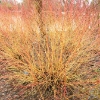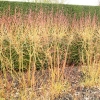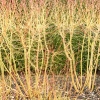Features
The smooth stems (which are yellow when new) bear bright green leaves from spring, which turn a golden-yellow before falling in autumn. From early summer clusters of small, white flowers appear which turn to black drupes in the autumn. After leaf fall the bare stems display a brilliant orange-yellow colour throughout the winter, which can redden in sunny spots.
What to use it for
Great for borders and beds, especially to add winter interest. They look best planted in groups in front of a dark background, such as an evergreen hedge. Could be used as deciduous hedging and is useful for wildlife gardening if grown for the flowers/fruit rather than the winter stem interest. The stems are used in flower arranging.
How to look after it
Apart from regular pruning, this plant is low maintenance and requires no other care. However, you may find that you need to remove suckers regularly as they tend to pop up all over the place as the plant spreads out.
How to prune it
This dogwood should be pruned in early spring, before the buds break (open). How you prune it depends on what you want from the plant…
If you are growing it for the flowers and fruit then you should keep pruning to a minimum. If you need to restrict its size then remove a quarter of the old shoots from the base each year, which will also encourage more new growth. To renovate a neglected plant, prune out all the old wood from the centre of the plant, cutting it out from the base, which will encourage fresh growth.
If you are growing it for the winter stem colour, then you need to keep all the stems young, as the younger stems have the best colour. The first year after planting the shrub, don’t prune it at all, as this can cause it to die suddenly. In the second year cut all the stems down to 5cm from the ground. In subsequent years, or for established plants, cut all the stems back to leave just two buds of the previous year’s growth at the base of each stem (coppicing).
How to propagate it
The easiest way to propagate this dogwood is to take hardwood cuttings from late autumn to midwinter. Keep the cuttings outside, in a sheltered spot, to root.
Softwood cuttings can be taken just as the lenticels (tiny white pores) start to form on the stem in late spring or early summer. Nodal cuttings less than 7cm long should be taken, dipped in a weak rooting hormone compound and placed in cutting compost. They should root in 4 weeks.
Alternatively, seeds can be collected from ripe fruits in autumn and sown outdoors straight away (before they become dormant) or cold stratified for sowing in spring. Seeds from cultivars are unlikely to come true to type.
Common problems
Cornus anthracnose and die back can be a problem, as can viral diseases. Can be susceptible to attacks by aphids, vine weevil, mussel scale, horse chestnut scale and two-spotted spider mites.
Other useful information
It is thought that the common name of ‘dogwood’ derives from the use of the stems to make ‘dags’ (daggers, skewers or arrows), so the name may have started out as dagwood and eventually became dogwood (the term ‘dogwood’ can be dated back to the 1600s). An even older name for Cornus is ‘whippletree’, a name used as far back as Chaucer’s The Canterbury Tales (15th century). The term whippletree is still used today as a name of part of the mechanism by which horses draw vehicles or ploughs – the part was originally made from Cornus wood.
The species name ‘sanguinea‘ is the Latin for ‘bloody’ or ‘blood-red’, referring to the colour of the stems. This cultivar was discovered in a German garden by H.Venhorst in around 1980, and named ‘Midwinter Fire’ in 1990.
The phrase ‘dogwood winter’ is colloquially used to describe a sudden cold spell in April/May when dogwoods are flowering.










